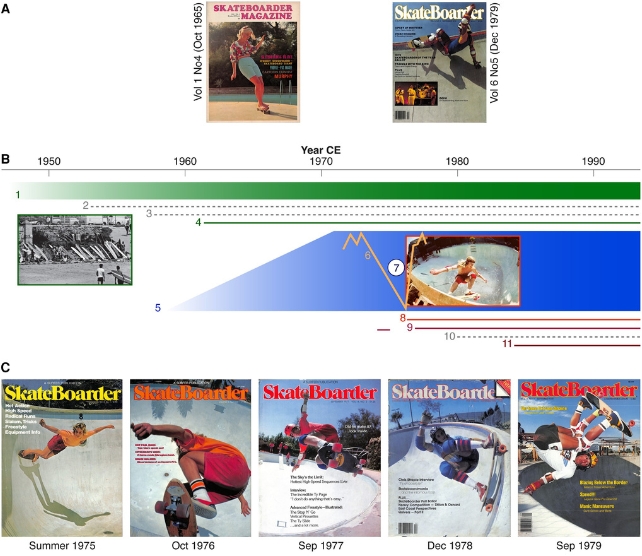
The flourishing surf culture and a dry spell in Southern California laid the groundwork for the emergence of pro skateboarding during the 1970s.
According to a recent study, the convergence of people and climate, rather than a mere coincidence, played a pivotal role in this phenomenon. Intricate relationships between individuals and the environment orchestrated the rise of pro skateboarding, uniquely unfolding in the distinctive setting of California.
The yearly creation of approximately 20,000 newly designed curved wall pools, enforced water-saving measures, and technological advancements such as digital photography and industrial polyurethane all played integral roles in fueling the surge in popularity of skateboarding.
Transforming vacant pools into skateboarding havens, surfers initiated a groundbreaking trend in late ’70s Los Angeles.
Nearly fifty years on, skateboarding has evolved into a thriving global industry worth billions. In their latest research paper, the international team of researchers elaborates on how this serves as a contemporary illustration of how minor environmental shifts can wield significant influence on society, redefine cultural standards, and catalyze innovative developments.
“The popularity and influence of surf culture was completely vital to the rise of skateboard culture, which is why it could have only happened in southern California,” says geographer Ulf Büntgen from the University of Cambridge in the UK.
“You could have had the same drought, the same pools somewhere like Phoenix, but since Phoenix doesn’t have an embedded surf culture, professional skateboarding couldn’t have originated there.”
Following inspiration from the 2001 documentary Dogtown and Z-boys, Büntgen and his colleagues delved into the intricate interplay of environmental, technological, and social factors. Their exploration aimed to understand how these elements collaborated to transform a local trend into a global subculture and industry.
In the 1950s, California witnessed a significant surge in surf culture, leaving an indelible mark on music, fashion, and lifestyles spanning from San Diego to San Francisco. The establishment of the Surfer magazine in 1962 solidified its status as a global icon of surf culture. Concurrently, the evolution of polyurethane production revolutionized sporting gear, eventually impacting skateboard wheels.
During the economic boom of the 1960s, over 150,000 pools were constructed in California, with a concentration in the Los Angeles area. However, a decade marked by prolonged dry conditions, culminating in the drought of 1976/77, resulted in agricultural losses and the implementation of water conservation laws. As part of water-saving initiatives, pools were emptied to address the impact of the drought.
“Our study shows that local climate triggers can have unexpected, and major, impacts on human society, and not all of them are negative – in this case, a drought in California led to the development of a huge industry,” Büntgen says.
With the formation of the Zephyr team in the ‘Dogtown’ neighborhood near the iconic Venice Beach in Santa Monica, the origins of freestyle skateboarding – initially a teenage pastime – underwent a transformation, giving rise to amateur halfpipe skating.
Examining the covers of Skateboarder magazine between 1975 and 1978 provides insights into the rapid evolution of skateboarding. According to the authors, skateboarding was relatively uncomplicated in 1975, as evidenced by a cover featuring Gregg Weaver on a flatboard designed for freestyle and street-style skating. However, by 1976, Tony Alva was showcased demonstrating advanced skills in the ‘Soul Bowl.’
In 1977, Paul Hackett’s gravity-defying maneuvers propelled the sport to unprecedented heights, followed by remarkable feats from Steve Olson at the Del Mar Skate Ranch in 1978. Eddie Elguera’s appearance on the cover in 1979 coincided with the global rise of vertical skateboarding, eventually overshadowing both street style and freestyle in popularity.

During the ‘Golden Age’ of skateboarding in the ’70s and ’80s, iconic brands such as Powell Peralta, Vision Street Wear, and Alva came to prominence. This era gave rise to global skateboarding stars like Tony Hawk, Danny Way, and Tony Magnusson, thrusting skateboarding into the international limelight.
With the rise in popularity of handheld digital cameras, skateboard videography emerged as a significant trend. Influential skateboarding films such as Bones Brigade from 1984 played a pivotal role in further propelling the growth of the skateboarding scene.
The influence of the sport extended to Europe, marked by events such as the Münster Monster Mastership in the 1980s. This competition evolved into the inaugural World Cup in 1989 and subsequently became the first official World Skateboarding Championship in 1990.
Established in 1994, the X-Games and the inclusion of skateboarding at the 2021 Tokyo Olympics have firmly cemented skateboarding’s influence on global subcultures, including its impact on hip-hop music and streetwear fashion. The reach of skateboarding extends even to snowboarding, a sport once known as ‘snurfing’ but rebranded in the wake of late 70s skateboarding mania.
“When you look a bit deeper, it confirms our thinking that climate and environmental factors deeply influence society,” Büntgen explains.
These developments are not random – in the case of skateboarding, you need each one of the ingredients to exist in the same place and time. It couldn’t have happened ten years earlier, ten years later, or a few hundred miles away.”
Highlighting the analytical potential of modern and perhaps unexpected instances in grasping the link between humans and climate, Büntgen and the team aspire to ignite further interdisciplinary research with their investigation.
The findings from the study are available in the journal PNAS Nexus.





